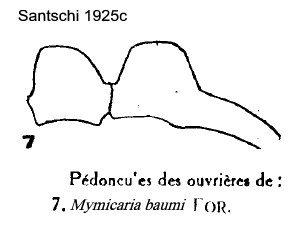Myrmicaria baumi Forel
  Type location Angola
(Myrmicaria Baumi n. sp.,
Forel, 1901d: 307, worker) from Cubango-Cuito - see below Type location Angola
(Myrmicaria Baumi n. sp.,
Forel, 1901d: 307, worker) from Cubango-Cuito - see below
worker only described (see Bolton, 1995)  . .
I have revived the status of Myrmicaria occidentalis
Santschi
which is smaller and readily separable from baumi.
|
 Santschi's
(1925) description follows (comparative statements mostly relate to natalensis)
- Santschi's
(1925) description follows (comparative statements mostly relate to natalensis)
-
WORKER - TL 7.3-9.5 mm. Dark red brown. Central area
of head with about ten longitudinal rugae, these are irregular,
anastomosed or reticulate and interrupted. Minors, and even less,
majors have a small smooth space on the vertex. The transverse ridge of
the vertex is strong or double and sinuous, behind the ridge the
longitudinal rugae continue but diverge. Rugae on the cheeks are
stronger and regular continuing into the scape area where they
anastomose. Sides of head more finely sculpted, without a smooth space
towards the lower border. Medial carina of alitrunk well developed,
reaching back to the transverse ridge separating the dorsum and
declivity of the mesonotum. In majors the arched rugae of the pronotum
dorsum are more transverse, and the posterior parts more parallel to
the median; in minors the arched rugae become less obviously parallel
to the median posteriorly; these often are very irregular and
reticulate especially on the shoulders.
Rugae of dorsal mesonotum longitudinal, regular and spaced out from the
median carina. Mesonotum declivity irregularly rugulose and striated
across in majors and lengthwise in minors. Propodeum dorsum grossly and
irregularly striated longitudinally, with rugae more spaced in the
minors, sometimes being more reduced towards the posterior. Lateral
alitrunk and summit of pedicel nodes with longitudinal or even
crossways (on nodes?) rugae. Tibiae, scapes and mandibles striated.
Head as wide or wider than long in majors, a little narrower in minors.
Slightly narrowing forward, posterior and lateral borders almost
straight; cervical border strongly convex. Eyes larger and more
forwards than natalensis. Frontal margin sinuous; frontal area
striated but not strongly. Clypeus smooth and carinate. Mandibles with
4 teeth. Funiculus like that of natalensis but less elongated.
Pronotum relatively larger and strongly dentate laterally as with natalensis.
Promesonotal suture impressed and mesonotal lobes developed. Propodeal
dorsum longer and less widened in front; only a quarter to one-third
longer than wide, with majors relatively longer than minors. Anterior
and posterior faces of petiole node symmetrical as in striata,
but with a longer and less elevated summit; wider than long.
Postpetiole nearly as high as the petiole, anterior face very oblique
(as in striata), but with the summit longer and the posterior
face vertical.
|